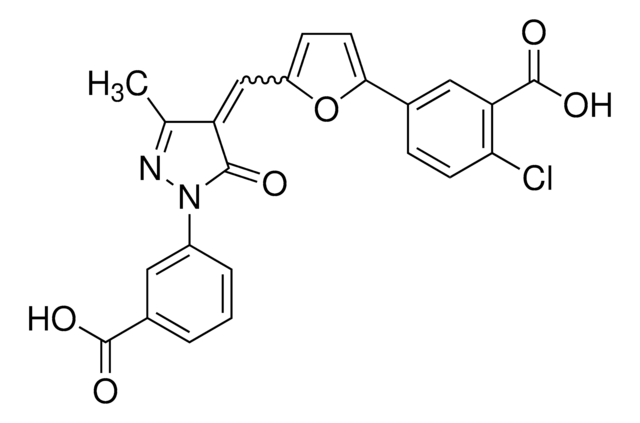344270
Forskolin
from Coleus forskohlii, ≥99% (HPLC), crystalline solid, positive inotropic agent, Calbiochem
Sinónimos:
Forskolin, Coleus forskohlii, 7β-Acetoxy-8,13-epoxy-1α,6β,9α-trihydroxy-labd-14-en-11-one, Colforsin
About This Item
Productos recomendados
product name
Forskolin, Coleus forskohlii,
assay
≥99% (HPLC)
Quality Level
form
crystalline solid
manufacturer/tradename
Calbiochem®
storage condition
OK to freeze
color
white to off-white
solubility
DMSO: 5 mg/mL
shipped in
ambient
storage temp.
10-30°C
InChI
1S/C22H34O7/c1-8-19(5)11-14(25)22(27)20(6)13(24)9-10-18(3,4)16(20)15(26)17(28-12(2)23)21(22,7)29-19/h8,13,15-17,24,26-27H,1,9-11H2,2-7H3/t13-,15-,16-,17-,19-,20-,21+,22-/m0/s1
InChI key
OHCQJHSOBUTRHG-KGGHGJDLSA-N
General description
Biochem/physiol Actions
Caution
Warning
Reconstitution
Other Notes
Noveen, A., et al. 1996. Biochem. Biophys. Res. Commun.219, 180.
Galli, C., et al. 1995. J. Neurosci.15, 1172.
Li, X., et al. 1995. Am. J. Physiol.269, C986.
Lomo, J., et al. 1995. J. Immunol.154, 1634.
Uneyama, H., et al. 1993. J. Biol. Chem.268, 168.
Laurenza, A., et al. 1989. Trends Pharmacol. Sci.10, 442.
Adashi, E.Y., and Resnick, C.E. 1986. J. Cell. Biochem.31, 217.
Seamon, K.B., and Daly, J.W. 1986. Adv. Cyclic Nucleotide Protein Phosphorylation Res.20, 1.
Huang, R., et al. 1982. Cyclic Nucleotide Res.8, 385.
Metzger, H., and Lindner, E. 1981. IRCS Med. Sci. Biochem. Cardiovasc. System Pharmacol.9, 99.
Legal Information
signalword
Warning
hcodes
Hazard Classifications
Acute Tox. 4 Dermal
Storage Class
11 - Combustible Solids
wgk_germany
WGK 3
Certificados de análisis (COA)
Busque Certificados de análisis (COA) introduciendo el número de lote del producto. Los números de lote se encuentran en la etiqueta del producto después de las palabras «Lot» o «Batch»
¿Ya tiene este producto?
Encuentre la documentación para los productos que ha comprado recientemente en la Biblioteca de documentos.
Los clientes también vieron
Nuestro equipo de científicos tiene experiencia en todas las áreas de investigación: Ciencias de la vida, Ciencia de los materiales, Síntesis química, Cromatografía, Analítica y muchas otras.
Póngase en contacto con el Servicio técnico









